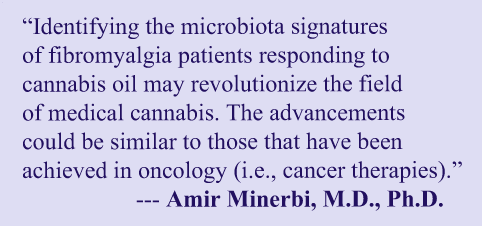Projects Funded
Gut Microbiota and Response to Cannabis Oil
Principal Investigator: Amir Minerbi, M.D., Ph.D.
Rambam Health Care, Haifa, Israel

Why do some fibromyalgia patients respond favorably to a medication, while all you get are side effects? This dichotomy is often explained by saying many different disease processes contribute to fibromyalgia. In other words, multiple abnormalities lead to the same fibromyalgia endpoint. However, there’s another reason: differences in gut bacteria or your microbiota.
Your microbiota forms a complex ecosystem that does so much more than assist with digestive functions. See Gut Influences for details.
Research by Amir Minerbi, M.D., Ph.D., shows that the microbiota of fibromyalgia patients is vastly different from what it should be. In fact, your microbiota “signature” can distinguish you from healthy controls 88 percent of the time.1 Minerbi found 19 microbial species are altered in patients. Although people with fibromyalgia differ from healthy folks, patients vary tremendously from one another.
Transferring gut microbiota from fibromyalgia patients to mice produces widespread pain in the mice.2 More importantly, the microbiota produce the same neurotransmitter, metabolic, and immunological abnormalities found in people with fibromyalgia. It even activates the mice’s immune cells in the brain (the microglia). Minerbi, along with colleagues from Canada and Ireland, led this transfer study to demonstrate the profound impact of an altered gut microbiota.*
Taking the microbiota’s role one step further, gut microbes influence a drug’s efficacy as well as its toxicity.3 Your microbiota can enzymatically change a medication to improve its effectiveness or, conversely, cause side effects. The gut microbes’ ability to alter medications probably explains why fibromyalgia patients respond differently to the same drug.
Take levodopa, for instance. Gut microbes influence the effectiveness of the drug for treating Parkinson’s disease. Response to various cancer therapies is also modulated by a person’s microbiota.4 Given the dramatic alterations in gut bacteria in fibromyalgia patients, the microbiota likely plays a key role in medication response as well.
Cannabis Trial
… with a Twist
The use of medical cannabis for fibromyalgia is increasing worldwide. Despite its endorsement in many countries, cannabis is not for everyone. “About 25 percent of patients achieve a clinically meaningful improvement in pain, while the side effects are common,” says Minerbi. “In this project, we propose to harness the insights gained by studying the gut microbiota in fibromyalgia patients to explore their individual response to cannabis oil.”
Minerbi predicts that individuals in the trial responding to cannabis oil will have a unique microbiota composition compared to the nonresponders. In addition, he will characterize the microbiota of the responders and use it as a tool to predict response to the drug. Minerbi will also do the same analysis for fibromyalgia patients experiencing adverse effects to cannabis oil.
A total of 150 fibromyalgia patients will be enrolled in a three-month study to evaluate the efficacy of medical grade cannabis oil. It’s a double-blinded trial where 120 patients will be carefully dosed up on cannabis oil and 30 patients will be given a placebo oil. All key symptoms of fibromyalgia (pain, fatigue, sleep disorder, physical function, anxiety, etc.) will be assessed along with the side effects. In addition to symptoms, Minerbi is also measuring each patient’s pain threshold before and after the trial.

Many survey-type studies, along with a few small trials, show cannabis is helpful for fibromyalgia. However, this study represents the first large-scale, placebo-controlled trial using medical grade cannabis oil.5 And it is not just a study to determine the percent of patients who favorably respond to the drug. The inclusion of microbiota assays makes it much more than just a clinical trial.
Medical Grade
When you take a medication, you know exactly how much of the active ingredient you are ingesting. The cannabis plant contains over a hundred different ingredients, but the two main active compounds being CBD and THC. Even if you get cannabis from a dispensary, you have no guarantees on what you are buying. This dose uncertainty is eliminated with the use of high quality, medical grade cannabis oil.
Minerbi convinced Panaxia Pharmaceuticals to generously donate their medical grade cannabis oil (along with a placebo oil). Using medical grade cannabis takes the guessing game out of interpreting the trial results. It also makes the study financially feasible for AFSA to fund. It’s a win-win situation.
Balanced Blend
If you are not familiar with cannabis, CBD and THC exert multiple actions, many of which are not fully understood. CBD is thought to reduce anxiety, but it probably doesn’t help with pain. On the other hand, THC can generate the “high” and some unwanted side effects. But the THC portion of cannabis is important for pain relief and aiding sleep in fibromyalgia.6 As a result, CBD is combined with THC to more effectively reduce symptoms.7
Medical grade cannabis oil with an equal portion of CBD and THC was chosen for the trial. Patients will be given cannabis oil containing 5% CBD and 5% THC. According to Minerbi, “A balanced CBD/THC preparation of medical cannabis has been shown in preliminary studies to produce the greatest pain relief in fibromyalgia.”
“Mild, transient side effects to cannabis are common, but severe side effects are rare,” says Minerbi. To minimize the unwanted effects, patients will dose up on cannabis oil very slowly. In addition, all trial subjects will be contacted weekly to ask about their well-being and potential side effects.
Study Implications
“This study investigates the possibility that the composition of the gut microbiota may predict response to cannabis oil in people with fibromyalgia,” says Minerbi. “If successful, this study will pave the way in understanding interpersonal variability in response to cannabis. In turn, this can lead to tailoring the treatment of medical cannabis to produce maximum benefits with minimal side effects.”
“Identifying the microbiota signatures of fibromyalgia patients responding to cannabis oil may revolutionize the field of medical cannabis,” says Minerbi. “The advancements could be similar to the achievements in oncology (i.e., cancer therapies).”
“The gut microbiota is modifiable,” points out Minerbi. “This makes it an attractive therapeutic target to optimize cannabis therapy for individuals with fibromyalgia. It could represent a major step forward in exploring targeted treatments for this poorly understood disease.”
One final point: This project assesses the microbiota, key symptoms, and pain thresholds in 150 fibromyalgia patients at two time points. Putting the cannabis trial results aside, this study provides the opportunity to track changes in symptoms with alterations in the microbiota. Minerbi has already found 19 microbial species that are different in patients. Quite possibly, microbiota alterations will correspond to specific fibromyalgia symptoms. If so, this study can lay the groundwork for targeted symptomatic therapies.
If you like this study, please help AFSA fund more research.
Stay current on Treatment & Research News: Sign up for a Free Membership today!
Learn about other Symptoms, along with Medication and Alternative Therapy approaches.
References
* Minerbi’s collaborators include Yoram Shir, M.D., Arkady Khoutorsky, DVM, Ph.D., and Emmanuel Gonzales, Ph.D., of McGill University in Canada and Nicholas Bremerton, Ph.D., of University College in Dublin.
- Minerbi A, et al. PAIN 160:2589-2602, 2019.
- Cai W, Shir Y, Minerbi A, Khoutorsky A, et al. BioRxiv Oct 28, 2023.
- Zimmermann M, et al. Mol Syst Biol 17:e10116, 2021
- Weersma RK, et al. Gut 69:1510-1519, 2020. Free Article
- Strand NH, et al. Biomedicines 11:1621, 2023.
- Boehnke KF, et al. Anesth Analg 138(1):5-15, 2024. Free Article
- Giorgi V, et al. Clin Exp Rheum 38(Suppl 123):53-59, 2020. Free Article
